| dc.contributor.author | Miller, Kimberly J. | |
| dc.contributor.author | Adair, Brooke S. | |
| dc.contributor.author | Pearce, Alan J. | |
| dc.contributor.author | Said, Catherine M. | |
| dc.contributor.author | Ozanne, Elizabeth | |
| dc.contributor.author | Morris, Meg M. | |
| dc.date.accessioned | 2019-05-28T08:56:38Z | |
| dc.date.available | 2019-05-28T08:56:38Z | |
| dc.date.issued | 2014 | |
| dc.identifier.citation | Miller, K. J., Adair, B. S., Pearce, A. J., Said, C. M., Ozanne, E., & Morris, M. M. (2014). Effectiveness and feasibility of virtual reality and gaming system use at home by older adults for enabling physical activity to improve health-related domains: a systematic review. Age and Ageing, 43(2), 188-195. | nb_NO |
| dc.identifier.uri | http://hdl.handle.net/11250/2599166 | |
| dc.description.abstract | Background: use of virtual reality and commercial gaming systems (VR/gaming) at home by older adults is receiving attention as a means of enabling physical activity.
Objective: to summarise evidence for the effectiveness and feasibility of VR/gaming system utilisation by older adults at home for enabling physical activity to improve impairments, activity limitations or participation.
Methods: a systematic review searching 12 electronic databases from 1 January 2000–10 July 2012 using key search terms. Two independent reviewers screened yield articles using pre-determined selection criteria, extracted data using customised forms and applied the Cochrane Collaboration Risk of Bias Tool and the Downs and Black Checklist to rate study quality.
Results: fourteen studies investigating the effects of VR/gaming system use by healthy older adults and people with neurological conditions on activity limitations, body functions and physical impairments and cognitive and emotional well-being met the selection criteria. Study quality ratings were low and, therefore, evidence was not strong enough to conclude that interventions were effective. Feasibility was inconsistently reported in studies. Where feasibility was discussed, strong retention (≥70%) and adherence (≥64%) was reported. Initial assistance to use the technologies, and the need for monitoring exertion, aggravation of musculoskeletal symptoms and falls risk were reported.
Conclusions: existing evidence to support the feasibility and effectiveness VR/gaming systems use by older adults at home to enable physical activity to address impairments, activity limitations and participation is weak with a high risk of bias. The findings of this review may inform future, more rigorous research. | nb_NO |
| dc.publisher | Age and Ageing | nb_NO |
| dc.subject | older people | nb_NO |
| dc.subject | virtual reality | nb_NO |
| dc.subject | gaming | nb_NO |
| dc.subject | physical activity | nb_NO |
| dc.subject | effectiveness | nb_NO |
| dc.subject | systematic review | nb_NO |
| dc.title | Effectiveness and feasibility of virtual reality and gaming system use at home by older adults for enabling physical activity to improve healthrelated domains: a systematic review | nb_NO |
| dc.type | Journal article | nb_NO |
| dc.source.pagenumber | 188-195 | nb_NO |
| dc.source.volume | 43 | nb_NO |
| dc.source.journal | Age and Ageing | nb_NO |
| dc.source.issue | 2 | nb_NO |
| dc.identifier.doi | https://doi.org/10.1093/ageing/aft194 | |
| dc.description.localcode | måsjekkes | |
